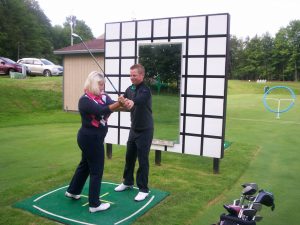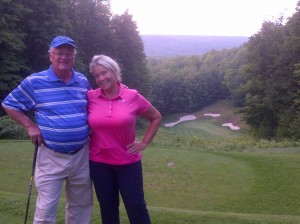If you had to pick one thing to feel good about in this golf season, what would it be? For me it’s what’s happening on the women’s side – both locally and nationally.
The Illinois Women’s Golf Assn. showed again that it isn’t reluctant to play its State Amateur in the Chicago area anymore. It was at Flossmoor in 2010, Ravisloe in 2012 and Cantigny this year, and the last two champions were Chicago players. This 80-year old tournament should move around the state, but from 1971 through 2008 it was almost entirely a downstate attraction. The tourney will benefit from continuing to play it regularly at Chicago courses.
The Illinois Women’s Open doesn’t have a location problem – it’s a fixture at Mistwood in Romeoville – but this year the tourney finally drew a heavy contingent of professional players. A bigger purse and a renovated course may have contributed to that.
On the professional side Jerry Rich surfaced again in a big way. Rich lured the Solheim Cup to his Rich Harvest Farms, in Sugar Grove, in 2009 and will host an even bigger event – the International Crown – in 2016. Rich wants to host the competition beyond that date as well. Hopefully he’ll be successful.
But this September couldn’t be a better time to spotlight women’s golf. Let me explain.
The men who labored on the PGA Tour have their Champions Tour to play on once they turn 50. As the Senior PGA Tour it was an immediate hit upon its founding in 1980, but the Ladies PGA Tour has struggled to get a similar circuit going. Now progress is clearly evident.
Its Legends Tour was created in 2000 but its growth has been slow. No more than three tournaments were held annually from 2000 to 2005. There was sporadic growth the next seven years, the number of events climbing to seven by 2012.
Just a year later the Legends actually seems like a bonafide circuit with a very big event coming up soon. The Legends has 13 tournaments on its 2013 schedule, three of them coming in September including its biggest event yet. The Legends Tour Championship presented by Humana will be played at one of my favorite getaway places, French Lick Resort in Indiana. It’ll be part of a week-long celebration of women’s golf that runs from Sept. 23-29.
In the weeks leading up to that big one there’ll be the Harris Charity Classic in Maine from Sept. 12-15 and BJ’s Charity Pro-Am in Massachusetts on Sept. 18.
The big one, though, is at French Lick — a four- to six-hour drive from Chicago depending on your starting point. The 54-hole tournament has, as of this printing, 66 entrants with 10 of them LPGA Hall of Famers and seven former Solheim Cup captains. They’ll play for a $500,000 purse, the biggest in Legends history, and the champion will received $75,000.
Not only that, but there’ll be a 36-hole Super Legends competition on the last two days of the week, featuring stars of the more distant past like Sandra Haynie (winner of the U.S. Women’s Open at LaGrange in 1974), Donna Caponi, Jane Blalock and Sandra Palmer.
Not only that, but there’ll be a Legends Hall of Fame established at French Lick with active Legend Jan Stephenson, winner of the circuit’s first tournament 13 years ago, heading the first class of inductees.
And, not only that, but there’ll be a two-day amateur event – the Alice Dye Invitational – to kick off the celebration. That event, to be held for the fourth time, has been extremely popular as part of French Lick’s annual calendar. Alice is the wife of Pete Dye, and both are course designers. The acclaimed Pete Dye Course will be used for the Legends competition, though it would be just as appropriate to have the women tee off on the Donald Ross Course there.
The hilly Ross layout hosted the men’s PGA Championship in 1924, with Walter Hagen winning, but it has an even bigger place in LPGA history. That circuit wasn’t organized until 1950, and three tournaments in its first decade were played at French Lick. The 1957 French Lick Women’s Open was won by Louise Suggs, and that event’s success led to the LPGA Championship being scheduled at the resort in 1959 and 1960. Two of the greatest women golfers of all time, Betsy Rawls and Mickey Wright, were the champions.
Suggs, Rawls and Wright will be inducted into the Legends Hall along with Stephenson and retired Legend Kathy Whitworth. The Hall will reside off the Atrium of the West Baden Springs Hotel.
I went to the Legends tourney announcement at French Lick 15 months ago. The event intrigued me then and excites me now. There aren’t nearly as many former LPGA stars who want to still compete as there are on the men’s side, but there are enough. I had Pat Bradley and Val Skinner as playing partners during my visit. Their skills haven’t diminished much, and they have growing company in that regard.
The Legends Tour now lists 120 members with a combined 675 LPGA tournament wins, including 70 major championships. Among the Legends members are two players who came out of Illinois to become LPGA regulars – Allison Finney (Winnetka) and Nancy Scranton (Centralia).
Though scheduling tournaments has been challenging, the Legends has paid out $10 million in prize money during its first 12 seasons and raised $13 million for charity. There have been events of one sort or another in 12 states – but not Illinois – plus Japan and Australia.
And now the Legends will put on their biggest show yet in southern Indiana. Adult tickets are $12.50 per day. In addition to the three days of Legends tournament play there’ll be a day-long clinic given by the LPGA greats as well as a pro-am in which they’ll be the featured attraction.
The community of French Lick fell on difficult economic times in the years after the LPGA’s last event there. It has recovered big-time as a golf destination, as attested to the landing of the 2015 Senior PGA Championship last month. French Lick has also hosted both the men’s and women’s Big Ten Championships twice and the Professional Players National Championship was also played there in recent years.
Now it’s the LPGA Legends turn. The event marks a breakthrough for the LPGA and women’s golf in general. It will be well worth the half-day drive.


